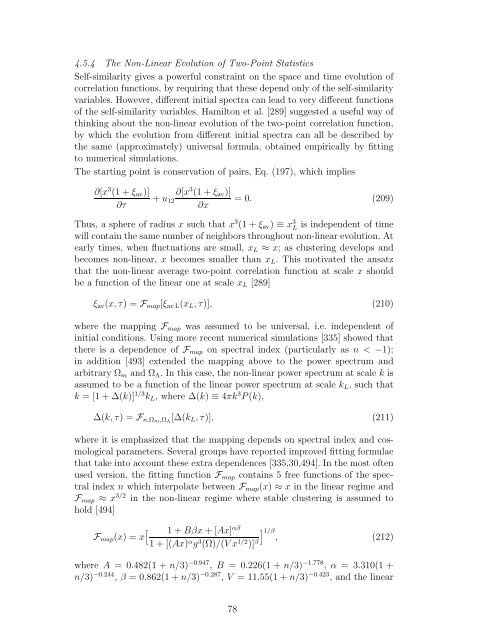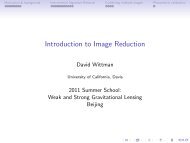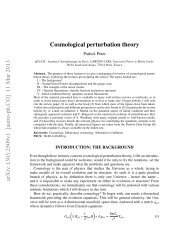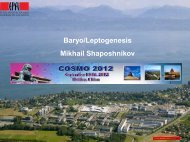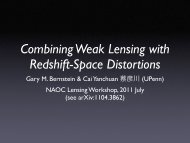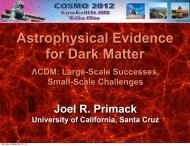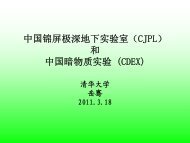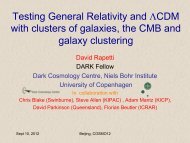Large-Scale Structure of the Universe and Cosmological ...
Large-Scale Structure of the Universe and Cosmological ...
Large-Scale Structure of the Universe and Cosmological ...
Create successful ePaper yourself
Turn your PDF publications into a flip-book with our unique Google optimized e-Paper software.
4.5.4 The Non-Linear Evolution <strong>of</strong> Two-Point Statistics<br />
Self-similarity gives a powerful constraint on <strong>the</strong> space <strong>and</strong> time evolution <strong>of</strong><br />
correlation functions, by requiring that <strong>the</strong>se depend only <strong>of</strong> <strong>the</strong> self-similarity<br />
variables. However, different initial spectra can lead to very different functions<br />
<strong>of</strong> <strong>the</strong> self-similarity variables. Hamilton et al. [289] suggested a useful way <strong>of</strong><br />
thinking about <strong>the</strong> non-linear evolution <strong>of</strong> <strong>the</strong> two-point correlation function,<br />
by which <strong>the</strong> evolution from different initial spectra can all be described by<br />
<strong>the</strong> same (approximately) universal formula, obtained empirically by fitting<br />
to numerical simulations.<br />
The starting point is conservation <strong>of</strong> pairs, Eq. (197), which implies<br />
∂[x 3 (1 + ξav)]<br />
∂τ<br />
∂[x<br />
+ u12<br />
3 (1 + ξav)]<br />
= 0. (209)<br />
∂x<br />
Thus, a sphere <strong>of</strong> radius x such that x3 (1 + ξav) ≡ x3 L is independent <strong>of</strong> time<br />
will contain <strong>the</strong> same number <strong>of</strong> neighbors throughout non-linear evolution. At<br />
early times, when fluctuations are small, xL ≈ x; as clustering develops <strong>and</strong><br />
becomes non-linear, x becomes smaller than xL. This motivated <strong>the</strong> ansatz<br />
that <strong>the</strong> non-linear average two-point correlation function at scale x should<br />
be a function <strong>of</strong> <strong>the</strong> linear one at scale xL [289]<br />
ξav(x, τ) = Fmap[ξav L(xL, τ)], (210)<br />
where <strong>the</strong> mapping Fmap was assumed to be universal, i.e. independent <strong>of</strong><br />
initial conditions. Using more recent numerical simulations [335] showed that<br />
<strong>the</strong>re is a dependence <strong>of</strong> Fmap on spectral index (particularly as n < −1);<br />
in addition [493] extended <strong>the</strong> mapping above to <strong>the</strong> power spectrum <strong>and</strong><br />
arbitrary Ωm <strong>and</strong> ΩΛ. In this case, <strong>the</strong> non-linear power spectrum at scale k is<br />
assumed to be a function <strong>of</strong> <strong>the</strong> linear power spectrum at scale kL, such that<br />
k = [1 + ∆(k)] 1/3 kL, where ∆(k) ≡ 4πk 3 P(k),<br />
∆(k, τ) = Fn,Ωm,ΩΛ [∆(kL, τ)], (211)<br />
where it is emphasized that <strong>the</strong> mapping depends on spectral index <strong>and</strong> cosmological<br />
parameters. Several groups have reported improved fitting formulae<br />
that take into account <strong>the</strong>se extra dependences [335,30,494]. In <strong>the</strong> most <strong>of</strong>ten<br />
used version, <strong>the</strong> fitting function Fmap contains 5 free functions <strong>of</strong> <strong>the</strong> spectral<br />
index n which interpolate between Fmap(x) ≈ x in <strong>the</strong> linear regime <strong>and</strong><br />
Fmap ≈ x 3/2 in <strong>the</strong> non-linear regime where stable clustering is assumed to<br />
hold [494]<br />
Fmap(x) = x 1 + Bβx + [Ax] αβ<br />
1 + [(Ax) αg3 (Ω)/(V x1/2 )] β<br />
1/β , (212)<br />
where A = 0.482(1 + n/3) −0.947 , B = 0.226(1 + n/3) −1.778 , α = 3.310(1 +<br />
n/3) −0.244 , β = 0.862(1 + n/3) −0.287 , V = 11.55(1 + n/3) −0.423 , <strong>and</strong> <strong>the</strong> linear<br />
78


